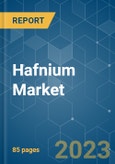The market for hafnium is expected to register a CAGR of over 7% during the forecast period.
This product will be delivered within 2 business days.
Key Highlights
- The COVID-19 pandemic negatively impacted the hafnium market. Due to the lockdown and brief halts in production facilities, several applications suffered significant damage, limiting hafnium consumption. Nonetheless, beyond 2020, the market has developed slowly due to ongoing efforts in the main end-user categories and is likely to continue on its path.
- Major factors driving the market are the rising demand for hafnium in the aerospace industry and its increasing usage in semiconductors and submarines. However, higher prices of the material as well as difficulties faced in extraction and separation, are likely to hinder the market growth.
- The increasing application base for various hafnium products is anticipated to provide numerous growth opportunities over the forecast period. China is expected to dominate the market across the world. However, Europe is considered to be the fastest-growing region in the world.
Hafnium Market Trends
Super Alloys Application to Dominate the Market
- Hafnium is majorly used as a superalloy, and this application accounts for more than 50% of the total usage of hafnium. Due to its high strength and stability when operating at very high temperatures, hafnium is used as a superalloy for applications in aerospace and industrial turbines.
- Hafnium superalloys are mostly found in jet and rocket engines. Hafnium makes up roughly 10% of the niobium-based alloy used in rocket engine nozzles. It is regarded as indispensable in the MAR M 247 superalloy, used in the hot section of jet engines (turbine blades and vanes).
- Hafnium superalloys are potentially used in industrial turbines, which are majorly used to produce electricity. Hence the growing trends in the power generation industry and wind energy generation will favor the growth of hafnium superalloys.
- According to the British Petroleum (BP) Plc statistics, global electricity generation in 2021 was 28,466.3 Terawatt-hours (TWh), registering a growth rate of 6.2%, compared to 26,889.2 TWh in 2020. In 2021, out of the total electricity generated, oil, natural gas, and coal-based electricity generation accounted for 720.3 TWh, 6518.5 TWh, and 10,244.0 TWh, respectively.
- In May 2022, J-Power USA Development Co. Ltd. (J-POWER USA) achieved commercial operation with the first two Mitsubishi Power M501JAC gas turbines manufactured in North America at its Jackson generation project, a 1,200 megawatt (MW) combined-cycle power plant in Elwood, Illinois, United States.
- Owing to the rising importance of superalloys in various industries, the demand for the hafnium market is expected to grow during the forecast period.
China to Dominate the Asia-Pacific Region
- In China, hafnium is used in nuclear reactors, aircraft, industrial turbines, and other industries in the form of sponges, alloys, and other forms. Hafnium is used in nuclear reactors to make control rods due to its strong neutron-capture cross-section and neutron-absorbing capabilities.
- Hafnium is widely used in China, which, as of June 2022, has 53 working nuclear power plants with 55.78 GW capacity. The country has 20 under-construction plants, which may increase the consumption of hafnium during the forecast period.
- In September 2022, China approved 2 nuclear plants worth USD 11.5 billion, completing the list of 10 nuclear power units sanctioned by the country in 2022. The power plants are expected to sort out the country's crippling power shortage condition and trigger higher consumption of hafnium.
- In December 2021, China unveiled a USD 440 billion investment plan to develop at least 150 new nuclear reactors over the following 15 years. The country currently has 19 reactors under construction, 43 reactors seeking permits, and a whopping 166 reactors announced. These 228 reactors have a total capacity of 246GW. Throughout the projected period, the development of nuclear power plants is expected to drive the hafnium market.
- China is also one of the leading aircraft manufacturers and one of the largest domestic air passenger markets. Furthermore, the country's aviation parts and assembly manufacturing sector has been quickly expanding, with over 200 minor aircraft parts manufacturers present. The Civil Aviation Administration of China (CAAC) estimates that domestic traffic will recover roughly 85% of pre-pandemic levels.
- According to the Boeing Commercial Outlook 2021-2040, in China, around 8,700 new deliveries will be made by 2040, with a market service value of USD 1,800 billion. The demand for hafnium will likely rise due to such new deliveries in the country.
- All the aforementioned factors, in turn, are expected to augment the consumption of hafnium in the country.
Hafnium Industry Overview
The hafnium market is highly consolidated, with the top two players accounting for approximately 80% of the production and supply of hafnium metal. Some of the market's major players (not in any particular order) include Framatome (EDF), Alkane Resources Ltd., American Elements, Nanjing Youtian Metal Technology Co. Ltd., and ACI Alloys, among others.Additional Benefits:
- The market estimate (ME) sheet in Excel format
- 3 months of analyst support
This product will be delivered within 2 business days.
Table of Contents
1 INTRODUCTION
4 MARKET DYNAMICS
5 MARKET SEGMENTATION (Market Size in Value)
6 COMPETITIVE LANDSCAPE
7 MARKET OPPORTUNITIES AND FUTURE TRENDS
Companies Mentioned (Partial List)
A selection of companies mentioned in this report includes, but is not limited to:
- ACI Alloys
- Alkane Resources Ltd
- American Elements
- Baoji ChuangXin Metal Materials Co. Ltd (CXMET)
- China Nulear JingHuan Zirconium Industry Co. Ltd.
- Framatome (EDF)
- Nanjing Youtian Metal Technology Co. Ltd
- Phelly Materials Inc.
- Starfire Systems Inc.
Methodology

LOADING...










